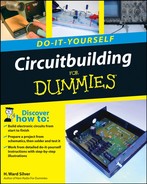Circuitbuilding skills come in extra handy when you can apply them on the spot to make repairs or rescue a broken gadget. You'll have to be prepared, though, and that's what this chapter is all about. By assembling an electronics first-aid kit, you'll be ready to tackle a lot of the "Murphy bites" that seem to occur at the most inopportune times.
Somewhere in your toolbox, keep a small plastic box with a selection of common transistors and ICs. Many circuits can be made to work, although possibly not at peak performance or under all conditions, with a substitute chip or transistor. Here's a good starter list of handy parts; add more that suit your specialty:
Bipolar transistors — 2N3904, 2N3906, TIP41, TIP42;
MOSFETs — 2N7000, IRF510;
Diodes — 1N4148, 1N4001, 1N4007;
Analog ICs — 741, LM324, 7805, 7812, LM386. (Sketch the pin configurations on a piece of paper you keep in the same box.)
Definitely useful in a pinch, a small bundle of various types of clip leads should be in your tool kit. Have a couple with heavy clips and wire that can handle currents of a few amps. A clip lead with a banana plug on one end can often replace a broken or lost multimeter probe.
Every toolbox should have a least one good-sized roll of quality electrical tape, such as Scotch 33+ or 88. Use it to replace heat-shrink tubing in a splice, to insulate a terminal (each layer is rated at 600 V or more), or waterproof a connection. A roll of cheap tape is good to have for holding things together. Electrical tape can also be used to make a temporary repair of small holes in hoses and tubes.
You will be amazed at what you can achieve just by twisting wires together, even for audio and video signals! Miniature wire nuts — cousins to the ones used for house wiring — work well for signal-level wiring. These don't have the holding power of the larger models, so give them a couple of wraps of tape to keep the connection together. Crimp splices are like butt-splice terminals, but they only have one end. Much like a crimp-on wire nut you can use a crimp splice to join two wires.
Call it an example of Murphy's Law: It's practically inevitable that cables with a molded-on connector (one whose body is solid plastic) will fail so close to the molded portion that there isn't room for a real splice. So use a very sharp pair of wire cutters (the pointier the nose of the cutters, the better) to dig into the molded plastic and expose enough wire for a temporary splice. Don't use a knife; it's way too easy to cut into the wire (or yourself) that way. Cutters allow you to work with much more control as you gradually expose the wires.
A soldering iron that can run off a car's cigarette lighter is occasionally a lifesaver. Keep one in your car in a sturdy bag, along with some solder, electrical tape, a pair of needle-nose and wire-cutting pliers. The power cord for these irons usually has a cigarette lighter plug. Purchase or make an adapter that changes the plug into clips that can be attached directly to the battery. You can also use a soldering iron to punch small holes in thin plastic — it doesn't smell very good, though, so do this in a well-ventilated area.
When you're attempting a field repair, all your cool tools, clamps, and work aids are back at home — which can make soldering or splicing a job for an octopus. The solution is to use wooden clothespins or pliers with rubber bands around the handle as your working vise. These will steady the work piece enough for you to work on it without slipping.
Intermittent connections are often caused by connectors with loose contacts. For example, the inner contact of a phono jack can work loose over time, either from many insertion-removal cycles or because the cable is twisted sideways while inserted. To bring this kind of sleeve contact back to life, squeeze its halves together gently with needle-nose pliers until it grips the mating connector pin firmly. If the contact is completely surrounded by a connector's body material, a jeweler's screwdriver can often be slipped between the contact and the body to force the contact towards the center.
If the antenna for a VHF or UHF radio (such as a scanner or a Family Radio Service handheld two-way radio) is broken off or lost, substitute a length of wire stuffed into the connector's center contact socket. You'll get best results if the antenna is about ¼-wavelength long at the frequency of interest. Use this formula:
Length (in inches) = 2808 / frequency (in megahertz)
For VHF frequencies near 150 MHz (for example), this type of antenna is about 19 inches long. For FM radios or portable TVs, the broken piece of antenna can be crimped a little with pliers and stuffed back inside the part mounted to the equipment. A miniature hose clamp will hold the two pieces together until the antenna can be replaced.
Yet another example of Murphy's law: Rechargeable batteries or power packs can always tell when you don't have a charger handy, can't they? That's usually when they run out of power. In a pinch, of course, you can do a quick-charge on a battery pack from a car's battery — but be careful:
Warning
Don't connect the batteries directly to the car battery — they'll overcharge and could become extremely hot or explode!
Tip
Use clip leads to connect a brake light or turn-signal bulb in series with the batteries to be charged. The bulb will absorb the initial inrush of current and act as a brake on the charging process.
If you feel the discharged batteries getting warm, stop charging! You can use the partially charged batteries for a while until you can replace them.
